|
|
|
Sort Order |
|
|
|
Items / Page
|
|
|
|
|
|
|
| Srl | Item |
| 1 |
ID:
060835
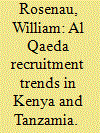

|
|
|
|
|
| Publication |
Jan-Feb 2005.
|
| Summary/Abstract |
At first glance, Kenya and Tanzania, the scene of some of Al Qaida's most impressive attacks, would appear to be fertile ground for recruiting militants into the global Islamist jihad. Substantial Muslim populations, widespread poverty, poor policing, inadequate border control, and systemic political and economic corruption would seem to make these East African countries potentially rich environments in which to attract new Al Qaida members. However, other factors essential to the terrorist recruitment process are largely absent. Despite claims that the traditionally tolerant Muslim populations of Kenya and Tanzania re being radicalized, the evidence suggests that Islamist radicals have in fact made little headway. Although individuals may have forged links with Al Qaida, Osama bin Laden and his network have few followers. Of course, this is subject to change. But in the near term, absent an environment of radicalism, as in a major recruitment ground like Pakistan, it is difficult to see how Al Qaida can expect to attract more than a handful of new members. That said, the United States could do far more in the region to prevent the emergence of violent Islamist extremism.
|
|
|
|
|
|
|
|
|
|
|
|
|
|
|
|
| 2 |
ID:
061796
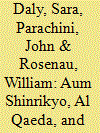

|
|
|
|
|
| Publication |
Santa Monica, Rand Corporation, 2005.
|
| Description |
xi, 75p.
|
| Standard Number |
083303761
|
|
|
|
|
|
|
|
|
|
|
|
Copies: C:1/I:0,R:0,Q:0
Circulation
| Accession# | Call# | Current Location | Status | Policy | Location |
| 049649 | 363.32/DAL 049649 | Main | On Shelf | General | |
|
|
|
|
| 3 |
ID:
019912
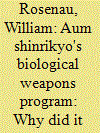

|
|
|
|
|
| Publication |
2001.
|
| Description |
289-301
|
|
|
|
|
|
|
|
|
|
|
|
|
|
|
|
| 4 |
ID:
052567
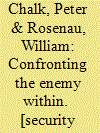

|
|
|
|
|
| Publication |
Santa Monica, Rand Corporation, 2004.
|
| Description |
xxi, 67p.
|
| Standard Number |
0833035134
|
|
|
|
|
|
|
|
|
|
|
|
Copies: C:1/I:0,R:1,Q:0
Circulation
| Accession# | Call# | Current Location | Status | Policy | Location |
| 048295 | 363.32/CHA 048295 | Main | On Shelf | Reference books | |
|
|
|
|
| 5 |
ID:
088683
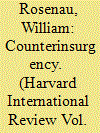

|
|
|
| 6 |
ID:
120435
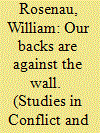

|
|
|
|
|
| Publication |
2013.
|
| Summary/Abstract |
This article addresses the gap in the literature on U.S. domestic terrorism and counterterrorism in the 1970s by examining a once-notorious but now largely forgotten terrorist group, the Black Liberation Army (BLA). An outgrowth of the Black Panther Party, the BLA was directly responsible for at least 20 fatalities, making it amongst the most lethal "homegrown" U.S. groups of the period. This article seeks to shed new light on the BLA by exploring its relatively short but violent trajectory. By focusing on the group's origins, operations, ideology, and structure, the BLA can be understood as part of a wider landscape of homegrown political violence. The BLA emerged during the waning phase of a protest cycle that included the civil rights, Black Power, and anti-war movements. Like other terrorist groups before and after, the BLA claimed to be acting in self-defense and on behalf of the people, presenting itself as an army resisting police occupation of minority communities. With the collapse of the extreme Left in the mid-1970s, the BLA's prospects for creating a broader revolutionary base became remote. The article also examines law-enforcement responses to the BLA and the competing ways in which the Federal Bureau of Investigation and local police (and in particular, the New York Police Department) framed and countered the BLA threat.
|
|
|
|
|
|
|
|
|
|
|
|
|
|
|
|
| 7 |
ID:
069738
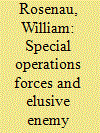

|
|
|
|
|
| Publication |
Santa Monica, Rand Corporation, 2001.
|
| Description |
xi, 60p.
|
| Standard Number |
083303071X
|
|
|
|
|
|
|
|
|
|
|
|
Copies: C:1/I:0,R:0,Q:0
Circulation
| Accession# | Call# | Current Location | Status | Policy | Location |
| 045222 | 355.422/ROS 045222 | Main | On Shelf | General | |
|
|
|
|
| 8 |
ID:
070271
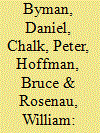

|
|
|
|
|
| Publication |
Santa Monica, Rand Corporation, 2001.
|
| Description |
xxiv, 138p.
|
| Standard Number |
0833030523
|
|
|
|
|
|
|
|
|
|
|
|
Copies: C:1/I:0,R:0,Q:0
Circulation
| Accession# | Call# | Current Location | Status | Policy | Location |
| 045274 | 322.42/BYM 045274 | Main | On Shelf | General | |
|
|
|
|
| 9 |
ID:
132293
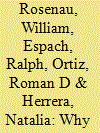

|
|
|
|
|
| Publication |
2014.
|
| Summary/Abstract |
For nearly ten years the Colombian government has systematically debriefed men and women who have left the Revolutionary Armed Forces of Colombia (FARC) and other violent extremist organizations. Today, the Colombian government maintains a database of more than 15,000 digitized interview transcripts-the largest of its kind in the world. With the proper enhancements and analysis, the database can provide critical insights into topics such as extremist recruitment, motivation, information operations, intelligence activities, leadership, and tactical and operational adaptation and innovation. Although Colombia's political violence is unique in many respects, further research using the database contributes to our understanding of the dynamics of insurgency in other regions. Ultimately, this research could enhance efforts to prevent recruitment into, and encourage current members to exit from violent non-state groups, such as gangs, terrorist groups, militias, and drug trafficking organizations.
|
|
|
|
|
|
|
|
|
|
|
|
|
|
|
|
|
|
|
|
|